
International Journal of Agriculture, Environment and Biotechnology
Citation: IJAEB: 13(4): 475-482, December 2020
DOI: 10.30954/0974-1712.04.2020.13

AGRONOMY
Integrated Resource Management Impact on Productivity of Pigeon Pea [Cajanus cajan (L.) Millsp.] in Hilly Tracts of Tripura, India
ABSTRACT
Pigeon pea [Cajanus cajan (L.) Millsp.] is the rich sources of dietary protein, carbohydrate & certain minerals, but its poor yield needs to formulate proper nutrient and pest management practices for higher productivity in upland alfisols of NEH regions and to combat it, an experiment was conducted during three consecutive kharif seasons at College of Agriculture, Lembucherra, Tripura comprising of eight nutrient and pest management combinations (T1-RDF (20: 60: 40); T2-T1+2% urea spray at 50% flowering; T3-T1+ 0.5% Borax spray at 50% flowering; T4- T1+ 0.5% ZnSO4 spray at 50% flowering; T5-T1 + 1% urea + 0.25% ZnSO4 + 0.25% Borax spray at 50% flowering; T6-T1+ Multimicronutrient spray @2 ml/litre at 50% flowering; T7-T1 + Indoxacarb at flowering + One systemic insecticide 15 days after the first spray; T8-T6+ Indoxacarb at flowering + One systemic insecticide 15 days after the first spray) in RBD design. It was revealed that micro-nutrient application in a combination of insecticide spray at flowering leads to better growth, higher yield (1.84 t/ha), and return per rupee (2.93), respectively.
Highlights
 Low fertility and pest damage leads to a poor yield of pigeonpea in NEHR.
Low fertility and pest damage leads to a poor yield of pigeonpea in NEHR.
 Management through micro-nutrient and plant protection chemicals.
Management through micro-nutrient and plant protection chemicals.
Keywords: Flowering, economics, micro-nutrient, pest, insecticide, pigeonpea
Pigeon pea [Cajanus cajan (L.) Millsp.] is the most versatile food legume with diversified uses as food, feed, fodder, and fuel. It accounts for 5% of global pulse production. Of the global acreage and production, Asia is nearly the sole contributor, and of that too, India alone accounts for over three-fourths of area and four-fifths of production (Ahlawat et al. 2005). Pigeon pea ranks second in both acreage (3.58 million ha) and production (2.74 million tonnes) among the pulses in India, with average productivity of 765 kg/ha. Pigeon pea is the rich source of dietary protein, carbohydrates, and certain minerals in the vegetarian diet in India (Gopalan et al. 1971). Besides being the major sources of dietary protein, they also play an important role in sustaining nutrient level in soil productivity by fixing atmospheric nitrogen (Kumar Rao and Dart 1987) for crop productivity. On the upland hill slopes, pigeon pea serves as a soil conserving crop and check erosion to some extent. However, there are many factors influencing the yield of pigeon pea. On-field condition, soil moisture, temperature, soil pH, mineral nutrient supply, salinity, and damage by pests are presumably the most important factors limiting the yield of pigeon pea (Kumar Rao 1990). As per as the productivity is concerned, pigeon pea has been observed almost stagnation throughout the state. Farmers are not very much interested in cultivating pigeon pea because of low yield due to proper nutrition and pest attacks.
How to cite this article: De, B., Giri, U., Das, P., Hazari, S., Awasthi, D.P., Thangjam, B.C. and Sen, D. 2020. Integrated Resource Management Impact on Productivity of Pigeon Pea [Cajanus cajan (L.) Millsp.] in Hilly Tracts of Tripura, India. IJAEB, 13(4): 475–482.
Source of Support: All India Coordinated Research Project on Pigeon pea, Indian Institute of Pulses Research (ICAR), Kanpur, U.P. and Department of Agriculture and Farmers’ Welfare, Government of Tripura; Conflict of Interest: None 
To combat the above stated low yield by standardizing a specific nutrient and pest management techniques for higher productivity in pigeon pea, an experiment was designed to find out the impact of nutrient and pest management on mid duration pigeon pea [Cajanus cajan (L.) Millsp.] in low fertile North -Eastern Hilly tracts of India.
MATERIALS AND METHODS
The field experiment was conducted during three consecutive Kharif seasons from 2016, 2017, and 2018 at the research farm of College of Agriculture, Lembucherra, Tripura situated between 22°57’ N latitude and 91°09’ E longitude. The soil of the experimental site was sandy loam having a pH of 5.4, organic carbon (0.79 gm/kg), available nitrogen of 260.0 kg/ha, available phosphorus of 19.0 kg/ha, and available potash of 123.0 kg/ha. The experiment was carried out during the kharif seasons, where the climate of the hilly zone is sub-tropical in nature with distinctive characteristics of high rainfall and temperature (Fi. 1). The treatments are comprised of eight nutrient and pest management combinations. T1-RDF (20: 60: 40); T2-T1+ 2% urea spray at50% flowering; T3-T1+ 0.5% Borax spray at 50% flowering; T4- T1+0.5% ZnSO4 spray at 50% flowering; T5-T1 + 1% Urea + 0.25% ZnSO4 + 0.25% Borax spray at 50% flowering; T6-T1+ Multi-micronutrient spray @ 2ml/litre at 50% flowering; T7-T1 + Indoxacarb at flowering + One systemic insecticide 15 days after first spray; T8-T6 + Indoxacarb at flowering + One systemic insecticide 15 days after first spray. The treatments were replicated thrice in randomized block design. The plot size was 6 m x 5.6 m. Pigeon pea variety and seed rate were UPAS - 120 and 15 kg/ha, respectively. The crop sowing was carried out on 12th, 10th, and 6th of July and harvesting on 13th, 12th, and 9th of December, respectively, during the three years of experimentation. The crop took 150±5 days to attain maturity. Fertilizers were applied as per treatment schedule in the form of urea, single super phosphate, and murate of potash. The entire dose of N, P, and K were applied treatment-wise at the time of land preparation @ of 20, 60, and 40 kg/ha, respectively, which is common for all the treatments. Ten (10) nos. of plants were selected randomly from each plot for observation of growth parameters. The data collected from the field and laboratory experiments were subjected to statistical analysis appropriate to the design, and the treatment variations were tested for significance by F test. The cost of cultivation involved in the production of pigeon pea was calculated as per the treatment, and prices of the produce were taken as per the minimum support price (MSP) of ₹ 5800/q for pigeon pea.
Averages of recorded observation per replication per treatment were analyzed with a statistical package (Indostat services, Hyderabad) for a significant test. Pearson correlation and Duncan multiple range tests (DMRT) were prepared by SPSS Inc ver. 16. The statistical analysis of the observed data was done using the method of Gomez and Gomez (1984) for interpretation.
RESULTS AND DISCUSSION
Growth parameters
Plant height
The pooled data of plant height was significantly influenced by the effect of nutrient and pest management at harvest during the three years of trial (Table 1) but remain insignificant among the treatment as per results obtained by Duncan Multiple Range Tests (DMRT). The tallest plant height was recorded in T7 (302.67 cm) followed by T3 (287 cm) treatment, which might be due to proper nutrition at the right time led to the growth of the plants properly (Goud et al. 2016 and Dalbehera, 2016). The shortest plant height was recorded in T1 (RDF @ 20: 60: 40) treatment.
Root length
The effect of nutrient and pest management significantly influenced the root length of pigeon pea at harvest among the individual treatments (Table 1). From pooled data, the T4 (47.33 cm) treatment recorded the maximum root length followed by T8 (47 cm) treatment, but they are statistically at par as per DMR test. The minimum root length of 40 cm was observed in T2 and T7 treatment, and they are statistically at per both as per ‘F’ test as well as Duncan analysis. The highest results recorded by the T4 and T8 treatment might be due to good translocation of nutrition to the underground parts at the right time, which might have increased the root length. Dalbehera (2016) also have similar observations.
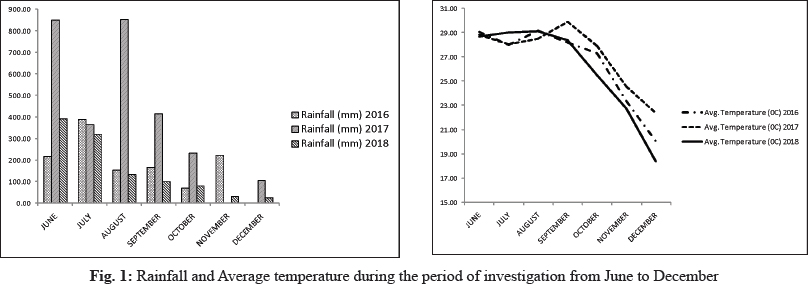
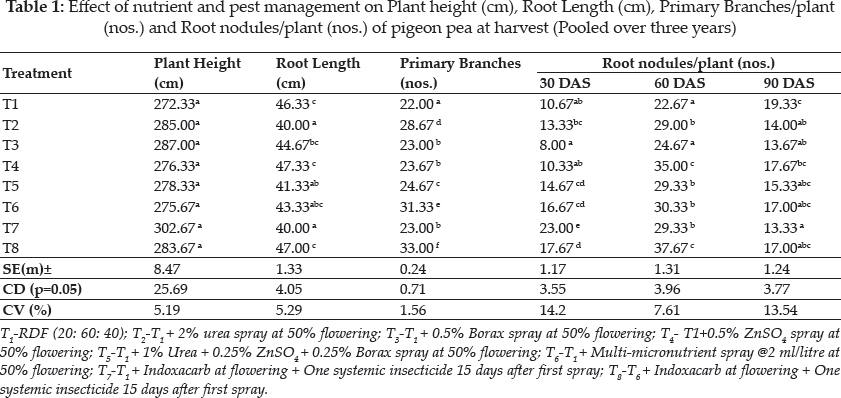
Number of primary branches/plant
The effect of nutrient and pest management significantly influenced the number of primary branches/plant of pigeon pea at harvest for the experimentation years and individual treatments (Table 1). The pooled data showed that T8 (33) recorded the maximum number of primary branches/plant followed by T6 (31.33) treatment, and they were statistically different among them and with others as well, as per Duncan analysis. The minimum number of primary branches/plant was observed in T1 (22) treatment.
The cubic curve fitting of seed yield with primary branches/plant (Fig. 6) showed that the initial treatments up to T5 (T1+1% Urea + 0.25% ZnSO4 + 0.25% Borax spray at 50% flowering) recorded a decrease in yield with the increase in primary branches indicating the heavy pest infestation from floral to pod initiation which reduced the yield, but the rest treatments managed the condition with the spray of multi-micronutrient in combination with plant protection chemical. This might be the possible reason for showing such a cubic curve, though there is no such literature found supporting it. But some related experiments by Ahlawat et al. (1975) and Ray et al. (2015) corroborated the findings.
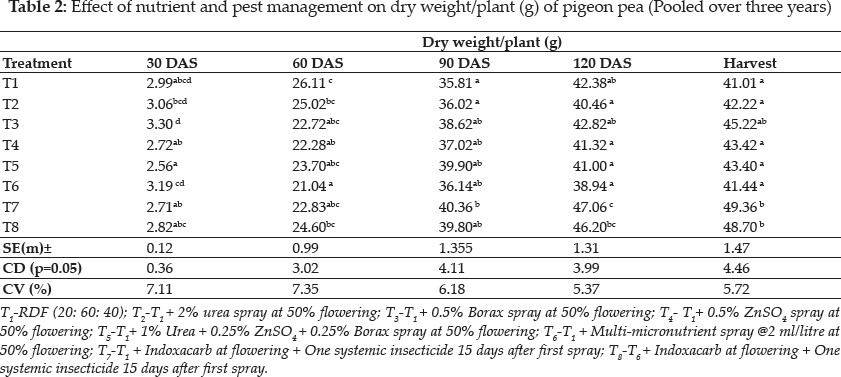
Number of nodules/plant
Observations from the pooled analyses showed that the effect of nutrient and pest management significantly influenced the number of nodules/plant of pigeon pea at all the dates of recording (Table 1). The number has increased gradually upto 60 DAS, and thereafter, it declined. The T8 (37.67) treatment recorded the maximum number of nodules/plant followed by T4 (35) treatment at 60 DAS, and it was reversed at 90 DAS, but they statistically differ from each other as per Duncan analysis at 90 DAS. Ray et al. (2015) and Dalbehera (2016) also have similar observations.
Dry weight of plant
The effect of nutrient and pest management also significantly influenced the dry weight of plant of pigeon pea at all dates of observation (Table 2). The dry weight of plants has increased gradually upto 120 DAS and remained stagnant at harvest, which might be due to the leaf senescence. From pooled data initially, T3 (3.30 g/plant) and T1 (2.99 g/plant) recorded the maximum dry weight of plant at 30 DAS and 60 DAS, respectively, but at the later stages of growth, T7 (40.36, 47.06 and 49.36 g/plant @ 90, 120 and harvest DAS respectively) treatment showed maximum accumulation of dry weight in the plants followed by T8 treatment which might be due to the proper supply of nutrition to the harvested products. They are found to be statistically among them as per Duncan analysis at harvest. Findings by Ray et al. (2015) and Dalbehera (2016) corroborate the results obtained.
Crop Growth Rate (CGR) & Relative Growth Rate (RGR)
The crop growth rate (CGR) of pigeon pea was significantly influenced by the effect of nutrient and pest management at all dates of observation (Fig. 2). The maximum CGR was recorded by the T7 treatment except at 30-60 DAS. The minimum CGR observed by different treatments at different dates of observations also have similar observations. Proper nutrition with multi-micronutrient spray might have increased the growth parameters like CGR and RGR (Goud et al. 2016 and Dalbehera 2016). The relative growth rate (RGR) of pigeon pea was significantly influenced by the effect of nutrient and pest management at all dates of observation (Fig. 3). The maximum RGR was recorded by the T7 treatment except at 30-60 DAS. The minimum RGR was observed by different treatments at different dates of observations. The same trend in CGR has continued in the case of RGR also.
Leaf Area Index (LAI) & Net Assimilation rate (NAR)
The effect of nutrient and pest management significantly influenced the Leaf area index (LAI) of pigeon pea at all dates of observations (Fig. 4). The T8 treatment recorded the maximum LAI followed by T6 treatment. The minimum LAI was observed in T2 treatment. The main reason being the uptake of proper nutrition led to increased primary branches, which in turn initiated more number of leaves per branch with higher plant canopy (Sharma et al. 2003 and Aziz 2002). The net assimilation rate (NAR) of pigeon pea was significantly influenced by the effect of nutrient and pest management at all dates of observation (Fig. 5). The maximum NAR was recorded by the T7 treatment except at 30 to 60 DAS and all the treatments. The minimum NAR was observed by different treatments at different dates of observations. Observations by Dalbehera (2016) also support the findings.
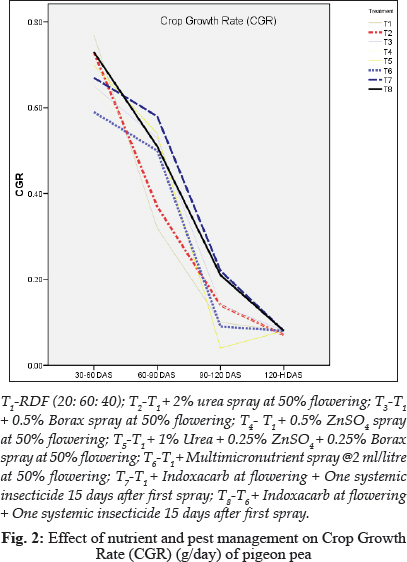
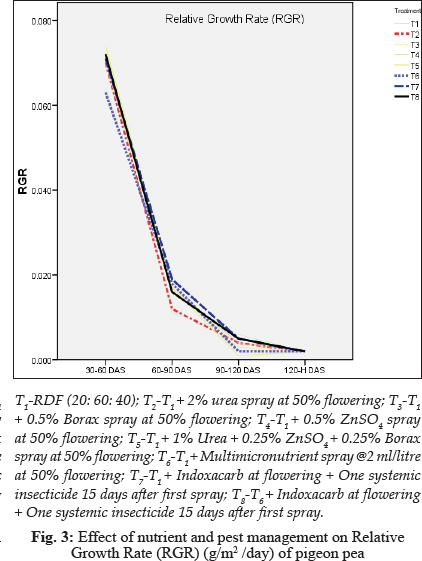
Yield attributes and yield parameters
Pod and seed yield
Pooled value depicted that the effect of nutrient and pest management significantly influenced the pod yield and seed yield of pigeon pea (Table 3). The T8 (2.39 and 1.84 t/ha) treatment recorded the maximum pod yield and seed yield followed by T6 (2.01 and 1.55 t/ha) treatment, and they statistically differ from each other both as per ‘F’ test as well as Duncan analysis. The minimum yields were observed in T2 (0.75 and 0.57 t/ha) treatment. Ray et al. (2015) and Aurangzeb et al. (1996) also have similar observations. The highest results recorded by the T8 treatment might be due to (i) proper nutrition at the right time, which might increase the growth of the plants properly and supply the nutrition to the harvested products, (ii) proper micronutrient spray, which might increase the no of flowers with reduced flower dropping, and iii) ultimately, application of right pesticides at the right time which might reduce the pest attacks that led the highest yield among all the treatments.
No of pods/plant and 100 seed weight
The effect of nutrient and pest management significantly influenced the yield attributes (number of pods/plant and seed index) of pigeon pea (Table 3). The pooled value of T8 (212.38) treatment recorded the higher number of pods/plant followed by T6 (200.65) treatment, which is statistically at par and differed significantly from others among them DMR test. The higher value of the seed index was measured by T2 (7.33 g) treatment followed by T8 (7.26 g), but they differed insignificantly. The minimum values of a number of pods/plant and seed index were observed in T2 (T1+2% urea spray at 50% flowering) and T5 (T1+1% Urea + 0.25% ZnSO4 + 0.25% Borax spray at 50% flowering) treatment, respectively. From the observations of Sharma et al. 2003 and Dalbehera (2016) it can be concluded that nutrient and insecticide spray might have increased the no of flowers with proper pollination as well as well matured pods and reduce the flower dropping and pest attack, which in turn recorded the maximum number of pods/plant.
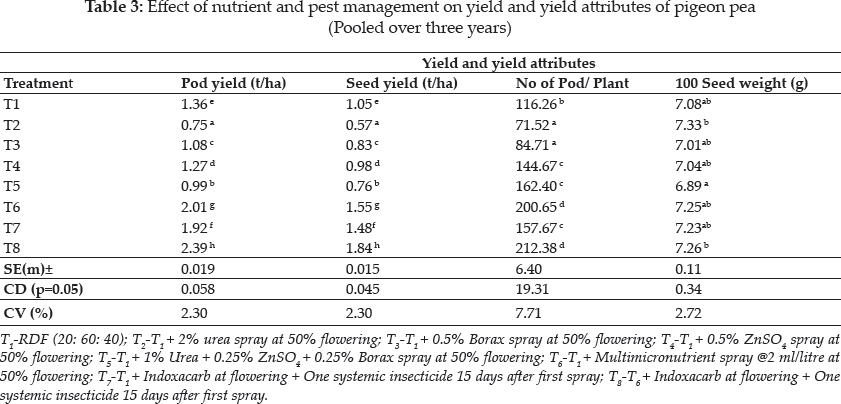
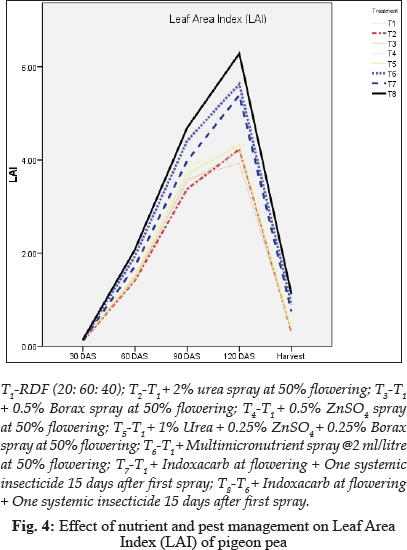
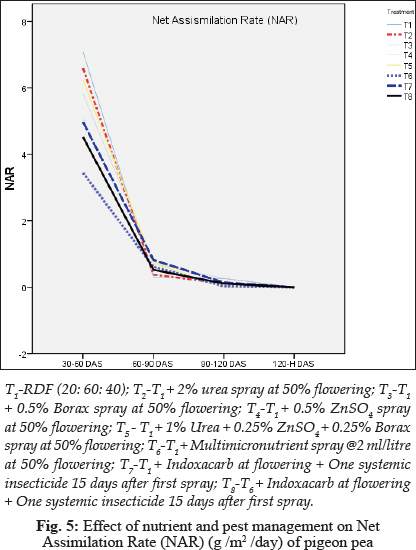
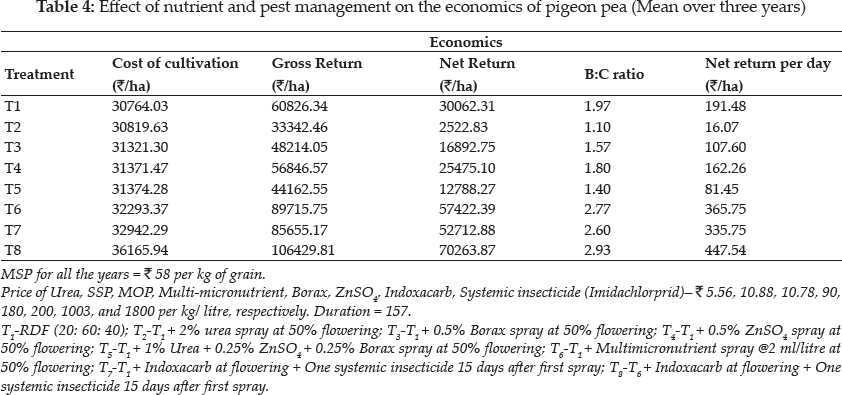

Economics
As seed yield, which decides the economics (Table 4), upon which the viability of a particular agro-technique depends for further dissemination and adoption to the farmer, showed that the T8 treatment recorded the highest return of ₹ 7026.87/ha and improved the economics of the crop (gross return, net return, B:C ratio, and net return per day) over other treatments followed by T6 (X 57422.39/ha) treatment from the pooled value of three years. The minimum values of the economics of the crop were observed in T2 treatment. Works by Kumawat et al. (2017) also revealed similar findings. Return per day for the whole period starting from sowing till harvest were formulated and found to be in the same trend as other economic parameters (Bhavi et al. 2013).
Pearson correlation
Correlation among the growth, yield, and economic parameters has a significant positive correlation with pod yield, seed yield, and net return. Again, the positive correlation of pod yield was found with seed yield and net return (Table 5), which is very important for the viability of any agro-techniques. A highly positive correlation was also observed between seed yield and net return. Few exceptions are a positive correlation of primary branches/ plant and 100 seed weight and negative correlation of plant height with primary branches and no of pods/plant.
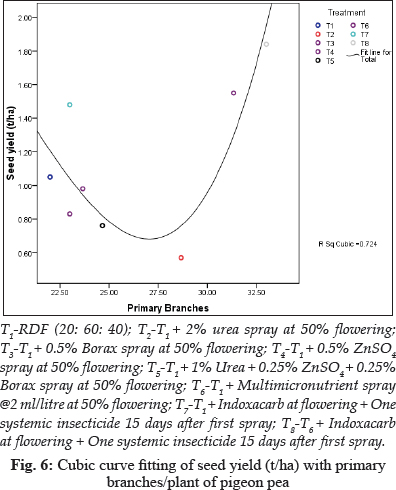
CONCLUSION
The study revealed that integrated application of multi-micronutrient with plant protection chemicals could effectively reduce the pest-nutrient provoked problems and results in the benefit of higher yield, which further can be recommended as an effective agro-technique to the marginal pigeon pea farmers of the northeastern region in general and Tripura in particular for better growth, yield and economic return of pigeon pea. This can also overcome the challenge faced by the farmers in pigeonpea cultivation of this region.
ACKNOWLEDGEMENTS
The research was jointly supported and funded by All India Coordinated Research Project on Pigeon pea, Indian Institute of Pulses Research (ICAR), Kanpur, U.P. and Department of Agriculture and Farmers’ Welfare, Government of Tripura.
REFERENCES
Ahlawat, I.P.S., Gangaiah, B. and Singh, I.P. 2005. Pigeon pea (Cajanus cajan) research in India-an overview. Indian J. Agric. Sci., 75(6): 309–20.
Ahlawat, I.P.S., Saraf, C.S. and Singh, A. 1975. Studies on performance of cultivar to doses of planting and row spacing. Indian J. Agron, 20(3): 245–247.
Aurangzeb, M., Naeem-Ur-Rehman and Ikramullah, A. 1996. Causes of low gram productivity in rainfed D.I. Khan: results from a farm level survey. JORDA, 28: 91–98
Aziz, M.A. 2002. Response of chickpea to nipping. Pakistan J. Scie. Industrial Res., 43(3): 191–193.
Bhavi, R., Desai, B.K. and Vinodakumar, S.N. 2013. Effect of planting geometry on the yield, nutrient availability and economics of pigeon pea genotypes. Trends in Biosciences, 6(6): 773–775.
Dalbehera, A. 2016. Effect of nutrient, weed and pest management practices on productivity of long duration pigeon pea [Cajanus cajan (L.) Millsp.] in rainfed condition. Thesis M Sc (Ag)., Banaras Hindu University, faculty of Agriculture, Varanasi, UP, India.
Gomez, K.A. and Gomez, A.A. 1984. Statistical Procedures for Agricultural Research. An IRRI Book, John Wiley & Sons, New York, USA. pp. 680.
Gopalan, C., Rama Sastri, B.V. and Balasubramanian, S.C. 1971. Nutritive value of Indian Foods. National Institute of Nutrition (NIN), Hyderabad, India, pp. 204.
Goud, V.V., Konde, N.M. and Patil, A.N. 2016. Effect of Planting Geometry on Growth, Nutrient Uptake and Yield of Medium Duration Pigeonpea Hybrid Under Rainfed Condition. Punjabrao Krishi Viswavidyalaya Research Journal, 40(1): 10–14.
Kumar Rao, J.V.D.K. 1990. Pigeon pea: nitrogen fixation, pp. 233–256. In: The Pigeon pea (Eds., Y.L. Nene, S.D. Hall and V.K. Sheila), CAB international, Wallingford, UK.
Kumar Rao, J.V.D.K. and Dart, P.J. 1987. Nodulation, Nitrogen fixation and N2 uptake in pigeon pea (Cajanus cajan L. Millsp.) of different maturity groups. Plant & Soil, 99: 255-266.
Kumawat, N., Kumar, R., Morya, J., Tomar, I.S. and Meena, R.S. 2017. Integrated nutrition management in pigeon pea inter-cropping systems for enhancing production and productivity in sustainable manner- A review. J. Appl. Nat. Sci., 9(4): 2143 - 2151.
Ray, S., De, B. and Hazari, S. 2015. Growth and productivity as influenced by nutrient management practices on pigeon pea [Cajanus cajan( L.) Millsp.] in upland alfisols of Tripura. SAARC J. Agric, 13(1): 123–134.
Sharma, A., Potdar, M.P., Pujari, B.T. and Dharmaraj, P.S. 2003. Studies on response of canopy modification and Plant Geometry. Karnataka J. Agril. Sci., 15(3): 466–471.
SPSS for Windows, S.I. 2007. Version 16. Chicago: SPSS Inc.